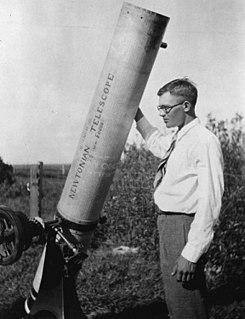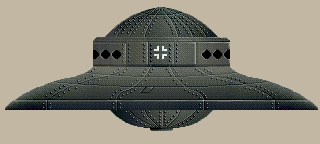
Clyde William Tombaugh was an American astronomer. He discovered Pluto in 1930, the first object to be discovered in what would later be identified as the Kuiper belt. At the time of discovery, Pluto was considered a planet, but was reclassified as a dwarf planet in 2006. Tombaugh also discovered many asteroids, and called for the serious scientific research of unidentified flying objects.

An unidentified flying object (UFO) is any perceived aerial phenomenon that cannot be immediately identified or explained. On investigation, most UFOs are identified as known objects or atmospheric phenomena, while a small number remain unexplained.

Sir Patrick Alfred Caldwell-Moore was an English amateur astronomer who attained prominence in that field as a writer, researcher, radio commentator and television presenter.

George Adamski was a Polish-American author who became widely known in ufology circles, and to some degree in popular culture, after he displayed numerous photographs in the 1940s and 1950s that he said were of alien spacecraft, claimed to have met with friendly Nordic alien Space Brothers, and claimed to have taken flights with them to the Moon and other planets.

The Maury Island incident refers to claims made by Fred Crisman and Harold Dahl of falling debris and threats by men in black following sightings of unidentified flying objects in the sky over Maury Island in Puget Sound. The pair would later claim the events had occurred on June 21, 1947.
In ufology, the psychosocial hypothesis, abbreviated PSH, argues that at least some UFO reports are best explained by psychological or social means. It is often contrasted with the better-known extraterrestrial hypothesis (ETH), and is particularly popular among UFO researchers in the United Kingdom, such as David Clarke, Hilary Evans, the editors of Magonia magazine, and many of the contributors to Fortean Times magazine. It is also popular in France since the publication in 1977 of a book written by Michel Monnerie, Et si les ovnis n'existaient pas?.

Jacques Fabrice Vallée is an Internet pioneer, computer scientist, venture capitalist, author, ufologist and astronomer currently residing in San Francisco, California and Paris, France.
Contactees are persons who claim to have experienced contact with extraterrestrials. Some claimed ongoing encounters, while others claimed to have had as few as a single encounter. Evidence is anecdotal in all cases.

In science fiction and in the beliefs of ufology, a Venusian or Venerian is a native inhabitant of the planet Venus. Many science fiction writers have imagined what extraterrestrial life on Venus might be like.

Many works of fiction have featured UFOs. In most cases, as the fictional story progresses, the Earth is being invaded by hostile alien forces from outer space, usually from Mars, as depicted in early science fiction, or the people are being destroyed by alien forces, as depicted in the film Independence Day. Some fictional UFO encounters may be based on real UFO reports, such as Night Skies. Night Skies is based on the 1997 Phoenix UFO Incident.
Frank Scully was an American journalist, author, humorist, and a regular columnist for the entertainment trade magazine Variety.

George Hunt Williamson, aka Michael d'Obrenovic and Brother Philip, was an American flying saucer contactee, channel, and metaphysical author who came to prominence in the 1950s.

In ufology, conspiracy theory, science fiction, and comic book stories, claims or stories have circulated linking UFOs to Nazi Germany. The German UFO theories describe supposedly successful attempts to develop advanced aircraft or spacecraft prior to and during World War II, and further assert the post-war survival of these craft in secret underground bases in Antarctica, South America, or the United States, along with their creators. According to these theories and fictional stories, various potential code-names or sub-classifications of Nazi UFO craft such as Rundflugzeug, Feuerball, Diskus, Haunebu, Hauneburg-Gerät, V7, Vril, Kugelblitz, Andromeda-Gerät, Flugkreisel, Kugelwaffe, Jenseitsflugmaschine, and Reichsflugscheibe have all been referenced.
Desmond Arthur Peter Leslie was a British pilot, film maker, writer, and musician. He was the younger son, and youngest child, of Shane Leslie, and his wife Marjorie.

James Willett Moseley was an American observer, author, and commentator on the subject of unidentified flying objects (UFOs). Over his nearly sixty-year career, he exposed UFO hoaxes and engineered hoaxes of his own. He was best known as the publisher of the UFO newsletters Saucer News and its successor Saucer Smear, which became the longest continuously published UFO journal in the world.

A flying saucer is a descriptive term for a type of flying craft having a disc or saucer-shaped body, commonly used generically to refer to an anomalous flying object. The term was coined in 1947 but has generally been supplanted since 1952 by the United States Air Force term unidentified flying objects. Early reported sightings of unknown "flying saucers" usually described them as silver or metallic, sometimes reported as covered with navigation lights or surrounded with a glowing light, hovering or moving rapidly, either alone or in tight formations with other similar craft, and exhibiting high maneuverability.

Gray Barker was an American writer best known for his books about UFOs and other paranormal phenomena. His 1956 book They Knew Too Much About Flying Saucers introduced the notion of the Men in Black to UFO folklore. Recent evidence indicates that he was skeptical of most UFO claims, and mainly wrote about the paranormal for financial gain. He sometimes participated in hoaxes to deceive more serious UFO investigators.

Karl Tomlinson Pflock born in San Jose, California was a CIA intelligence officer, Deputy Assistant Secretary of Defense in the Reagan Administration, strategic planner, UFO researcher, and author of both fiction and non-fiction. He was best known for his book Roswell: Inconvenient Facts and the Will to Believe.

The Aztec, New Mexico UFO hoax was a flying saucer crash alleged to have happened in 1948 in Aztec, New Mexico. The story was first published in 1949 by author Frank Scully in his Variety magazine columns, and later in his 1950 book "Behind the Flying Saucers". In the mid-1950s, the story was exposed as a hoax fabricated by two confidence men, Silas M. Newton and Leo A. Gebauer as part of a fraudulent scheme to sell supposed alien technology. Beginning in the 1970s, some Ufologists resurrected the story in books claiming the purported crash was real. In 2013, an FBI memo claimed by some Ufologists to substantiate the crash story was dismissed by the bureau as "a second- or third-hand claim that we never investigated".















